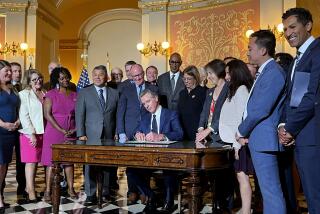Senate OKs Gasoline Tax for Seismic Work
- Share via
SACRAMENTO — Fearing that a costly earthquake safety program might gobble up revenues that were supposed to finance new road and rail projects, the Senate on Tuesday passed a temporary 2-cent-a-gallon gasoline tax increase to pay for nearly $1 billion in seismic retrofitting.
Senate approval of the new tax increase came almost one year after voters authorized a 9-cent-per-gallon gasoline tax hike so the state could embark on a massive rebuilding of its deteriorating transportation system.
The new 30-month tax increase--or gasoline surcharge, as its author, Sen. Quentin Kopp (I-San Francisco), preferred to call it--would go into effect July 1 and expire Jan. 1, 1994.
Determined to carry through with the new road and rail projects that they promised voters as an incentive to endorse the tax hike, senators approved the new increase 28 to 8 with bipartisan support and no debate. Republicans split on the issue with four favoring the tax increase and seven opposing it. Only one Democrat, Sen. Mike Thompson (D-St. Helena), joined the opposition.
Republican Leader Ken Maddy (R-Fresno) said most senators “felt strongly” that without the tax increase the specific road and rail projects they had promised voters in their districts could be jeopardized. Many also believed a gasoline tax hike would not be politically damaging, he said, because congestion-weary voters have already shown a willingness to approve taxes earmarked for transportation.
“I don’t know how else to (solve this problem) except with money,” he said.
But opponents are expected to pick up more support in the Assembly where the measure faces a rough road because of opposition from Transportation Committee Chairman Richard Katz (D-Sylmar). Katz, a moderate, is pushing a far different plan to pay for seismic retrofitting that would not require a tax increase and promises to draw support from conservatives.
“Kopp’s trying to solve the same problem; it’s just that we have a different approach,” he said.
Katz is suggesting the issuance of revenue anticipation notes, which would immediately provide additional funds for transportation. The bonds would be paid off by future gas taxes.
Katz said he thought the “overwhelming sentiment” in the Assembly was not to increase the gasoline tax at a time when lawmakers were considering boosting other taxes to solve a budget crisis and make up for a projected $14.3-billion deficit.
However, the key to whether gas taxes are increased, he said, may be Republican Gov. Pete Wilson, who so far has not taken a position on the issue.
“There are a variety of options available for consideration and we are reviewing all of them,” said Carl Covitz, Wilson’s secretary of business, transportation and housing.
The financial problems facing state officials stem mainly from a decision that the Legislature made after the Oct. 17, 1989, Loma Prieta earthquake to give the seismic retrofitting of bridges first priority on transportation revenues. With collapse of the Nimitz Freeway in Oakland and the deaths of 42 people still fresh in their minds, lawmakers demanded that all the bridges in the state be surveyed to determine their earthquake stability and then scheduled for retrofitting.
At the time, engineers estimated the cost of shoring up bridges at about $500 million. But when the more thorough surveys demanded by the Legislature were completed, the costs soared to a range of $1 billion to $3.4 billion. The lower cost would pay for retrofitting single-column bridges and the most vulnerable multi-column bridges. The higher figure would finance the retrofitting of all bridges.
Without an additional tax increase, Kopp said, the money for the earthquake safety program would have to be taken directly from the new gas tax revenues. The 9-cent-per-gallon increase was expected to help finance a 10-year, $18.5-billion transportation improvement program. So far only 6 cents of the phased-in tax has gone into effect.
The tax increase proposed by Kopp would provide just over $800 million in revenue, enough to complete the most critical phase of the retrofitting.
By passing the new tax, Kopp said, the Legislature would make the earthquake safety program “self-financing” and avoid the necessity of robbing other road and rail projects to pay for it.
To opponents who suggest that temporary taxes often end up permanent, Kopp pointed out that the quarter-cent sales tax approved by the Legislature had expired after 13 months as promised. The sales tax increase was designated to pay for repair of earthquake damage.
More to Read
Get the L.A. Times Politics newsletter
Deeply reported insights into legislation, politics and policy from Sacramento, Washington and beyond. In your inbox twice per week.
You may occasionally receive promotional content from the Los Angeles Times.










